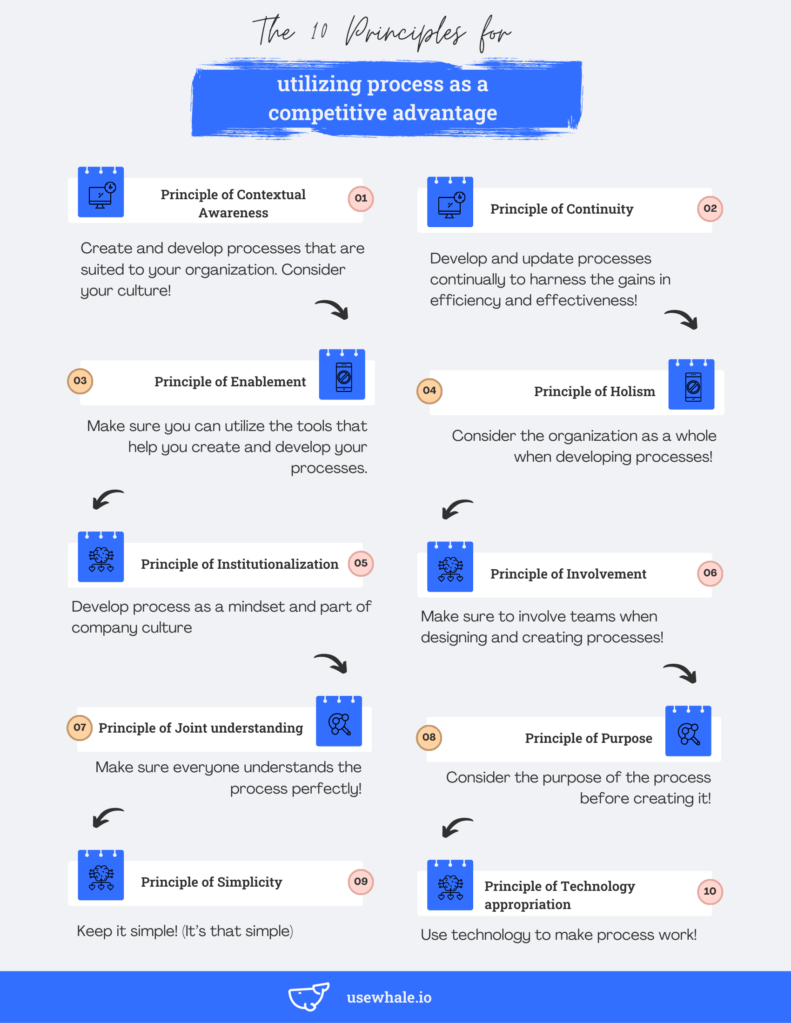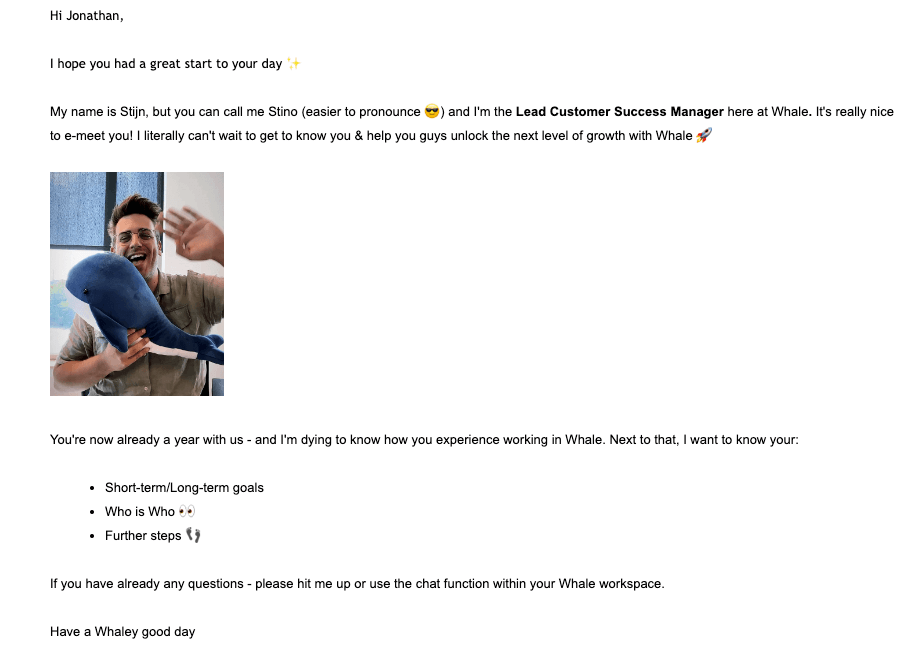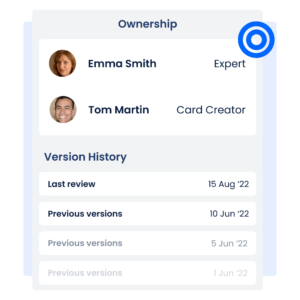"It’s not only what is done, but also how" states Process specialist and investor Ivan Seselj, advancing the argument that process can deliver the edge…
Process is important.
You probably know that having well-done AND well-utilized processes ensure that the right things get done by the right people at the right time. What you may not know is that it may just turn out to be the competitive advantage you’ve been looking for. 🤩
In fact, process could be one of your most valuable assets 🎯. Here’s how to use process as a competitive advantage.
Processes
- Systemize successful ways of doing things within a business
- Create consistency and operating and efficiency
- Decrease time involved in new employee onboarding
- Decrease decision-making fatigue
- And remove risk from both the business and your customer’s perspectives – something of quintessential importance to investors
If you’re looking to scale or even to build a business that you can scale to exit one day, process is a prime consideration. Not only do customers prefer businesses that operate efficiently and deliver quality products and services, but investors do too!
Competitive Advantage
Creating differentiators that a company can take to market to add superior value to its customers IS a company’s competitive advantage. In other words, it’s about what a company does that is different from its competitors that creates the gain 🌠.
Case in point?

There’s a reason that 28,958,000 people bought an 🍏 Mac in 2021. It’s the same reason that Apple Mac shipments grew twice as fast as the overall PC market.
“A key competitive advantage for the company is its ability to develop innovative products that share the same operating system, software, and applications. This minimizes the risk, timescale, and costs of product development, enabling the company to introduce a stream of new products and stay ahead of competitors.” (Bizfluent)
It’s not just what they do but how Apple does it that makes the difference.
The result is that their product strategy, as well as their brand, is a massive barrier to entry for competitors.
Companies that don’t define their differentiator or innovate in some way usually either become a commodity and have to compete solely on price as their value proposition. It’s never a good place to be!
Differentiating factors in business
Differentiators in business tend to come in 3 main categories;
People 👥
For the most part, people are replaceable, but the level of accomplishment and specialist knowledge of individuals within an organization can make a difference.
Technology 🖥️
The unique and compelling business value of technology and how it is deployed can create differentiation.
AND Process 🎯
How a business accomplishes its activities, goals, and positioning in alignment with customers’ business goals can create differentiation.
☝️ Incidentally, it’s process that can also help mitigate the risk associated with losing people and specialist knowledge in deploying technology.
The 10 principles for utilizing process as a competitive advantage
Professor Jan vom Brocke from the University of Liechtenstein and his clever colleagues created the Ten Principles of Good Business Process Management 😎.
- Principle of Contextual Awareness
- Principle of Continuity
- Principle of Enablement
- Principle of Holism
- Principle of Institutionalization
- Principle of Involvement
- Principle of Joint understanding
- Principle of Purpose
- Principle of Simplicity
- Principle of Technology appropriation
We thought we’d take their work and break it down into easy principles and ways to apply it in a business. We’ve also created an easy-to-use checklist to ensure that your organization can utilize process as a competitive advantage.

1. The Principle of Contextual Awareness
What it means? 🧐
Create and develop processes that are suited to your organization. Consider your culture!
You cannot adopt a one-size fits all approach with regard to process. That’s what competitive advantage means. It means you have a different approach to your competitors.
Whilst all organizations have to consider aspects of their operations such as HR, marketing, and development, the way your organization operates with respect to its customers is unique.
Therefore, processes should be adapted to suit the internal and external circumstances.
“It should fit the organization and, in particular, differentiate the management of business processes according to the process nature, e.g., degree of automation, standardization, repetitiveness, etc.”
✅ How to use it?
Think of the ways that you do things differently to your competitors and document it in your processes.
2. Principle of Continuity
What it means? 🧐
Develop and update processes continually to harness the gains in efficiency and effectiveness!
Process is often a once-off project that is done when chaos arises in an organization. Afterward, everyone breathes a sign of relief that it’s done, but it’s marked off and never evaluated again. But research found that process only leads to sustained competitive advantage if business processes are continuously improved (Trkman, 2010; Hammer, 2010).
It is important to go beyond only achieving quick wins. The principle of continuity stresses that updating process should be a permanent practice that facilitates continuous gains in efficiency and effectiveness.
If you want to improve your efficiency, then you must be able to measure your current processes. If those processes are not consistent, it is hard to know how to be more efficient.
Establishing a long-term approach and installing a process mindset is important in order to be able to leverage the potential and the value of business processes.
✅ How to use it?
Schedule process reviews quarterly or at a frequency that makes sense in your business. Check out our piece on how to review your SOPs and company documentation for more information on how to do this.
3. Principle of Enablement
What it means? 🧐
Make sure you can utilize the tools that help you create and develop your processes.
Most companies have great difficulty in defining their business processes. One group may define it one way, while others may define it very differently. Coming up with processes that make sense and are able to be utilized in the organization is key!
✅ How to use it?
Make use of great content and utilize tools, such as Whale, to their full extent!
If you’re in any doubt about the support given on Whale, then check out how our 5-Star Customer Success Manager Stino, welcomes and onboards new clients to ensure that they can utilize the platform fully.

4. Principle of Holism
What it means? 🧐
Consider the organization as a whole when developing processes!
It’s important to start with the most important parts of the business when documenting process, but this does not mean ignoring the rest of the business. Take a holistic approach when considering what processes to document but also how to document them.
When building process as a competitive advantage, the process should not have an isolated focus on specific areas of an organization, i.e., Developing processes should not be a project only in one or few departments but should apply across the entire business.
Consider, for example, employee onboarding. Whilst this mainly concerns HR processes, it actually spans the whole business.
✅ How to use it?
When developing process for the business, ask team members from different parts of the business to review it to see if it makes sense.
5. Principle of Institutionalization
What it means? 🧐
Develop process as a mindset and part of company culture
“To prevent process from being an ad-hoc responsibility, process owners with real responsibility, accountability, and authority are pivotal” (Power, 2011).
Too often, a business will find a tool or solution and try to enforce usability amongst team members. It is more efficient to make people responsible for process performance from the get-go. In this way ‘process’ becomes institutionalized.
Such adoption of process and documentation is also essential to sustain achievement and support continuity.
It’s all about creating a process mindset that is geared towards systemization and continuous improvement.
✅ How to use it?
Assign responsibility and accountability to internal team members and create KPIs within their respective roles with regard to process. This will help adopt an institutional mindset that is process-focused.
6. Principle of Involvement
What it means? 🧐
Make sure to involve teams when designing and creating processes!
The active involvement of team members in developing process fosters a true sense of ownership and even increases performance.
Enlist your team experts to own their respective business units and involve their team members in the process.
Studies found that organizations often attempt to limit team member involvement by simply gathering information through interviews and then having processes (re)designed by a dedicated team of experts (Rosemann, 2006).
The (re)design process, however, is likely to be more important than the final design. Utilize team members for process creation in a manner that will be utilized.
✅ How to use it?

Appoint subject matter experts to take overall responsibility for their respective processes but enlist the help of team members in the creation of great content that everyone will love and utilize!
7. Principle of Joint understanding
What it means? 🧐
Make sure everyone understands the process perfectly!
“Processes should not remain complex artifacts that can only be comprehended by experts or the legal team but instead should aspire to be simple and intuitive.”
Often, process is written in a way that only a few understand because of the language that is used. It can be complex and confusing if written with technical jargon.
The principle of joint understanding draws attention to process as a way to introduce a common language amongst everyone. Think about the way your business uses certain terms.
Don’t have 12-page process documents that no one will read, never mind understand. The aim here is for people to utilize and understand various processes.
✅ How to use it?
Think Netflix! Use content creators! And ensure that the culture of your brand is integrated across all processes and SOPs.
Use diagrams and images, and yes, if you have your processes drawn up in Whale, make sure to utilize video, emojis and GIFs for added

8. Principle of Purpose
What it means? 🧐
Consider the purpose of the process before creating it!
The requirement of a process is to align with a strategic mission and goals and to make them tangible and useful. Process is about creating transparency, efficiency gains, compliance, best practices, integration, and agility.
Ease of use helps create and improve the value that can be generated from processes, and it is also essential to creating a credible and supported practice of process adoption.
While this principle is seemingly obvious, it is in practice often forgotten. In practice, it is a common mistake to overdo and over-engineer some of the tasks, thereby forgetting the true purpose of the activity, e.g., creating a shared understanding that allows process improvement opportunities to be revealed.
“Then process becomes l’Art pour l’Art (Rosemann, 2006b): a self-absorbing exercise gaining and feeding off its own momentum without fulfilling a larger and wider purpose.“
✅ How to use it?
Focus on purpose by ultizing the 80-20 rule when documenting processes (EOS® Worldwide).
Focusing on the 20% that returns 80% of the result will help you gain traction and more value. For example, document 20% of the company processes that have 80% impact.
Leave out the non-essentials that only create complexity and diminish creativity.
9. Principle of Simplicity
What it means? 🧐
Keep it simple! (It’s that simple)
Creating processes can easily be set up, consuming enormous amounts of resources.
But does it yield reward? How does it help optimize efficiency or further the business? Don’t over-engineer. Think use case over compliance and choose to develop processes that contribute value in the simplest way possible.
“Focusing on simple solutions means balancing the inputs against the output of more efficient and effective organizational processes.”
Albert Einstein once said that “everything should be made as simple as possible, but not simpler.”
✅ How to use it?
An organization should carefully choose which processes require which level of attention from a strategic, technical, staffing, etc. viewpoint. Then make them really really simple!
10. Principle of Technology appropriation
What it means? 🧐
Use technology to make process work!

Platforms and tools can help to foster the efficiency and effectiveness of business processes. This isn’t about having your IT or technical team responsible for finding and implementing the relevant platform – it’s about utilizing technology across the organization to automate and systemize.
This will not only decrease human error or decision-making fatigue but will leave time and space open for creative problem solving, continuous improvement, and innovation.
✅ How to use it?
Find and evaluate the right Standard Operating Procedures Software and maximize its use within your business. Make sure to utilize specific criteria like integrations, support, and automation.
Automating process delivery will ensure quick access to knowledge and will provide the biggest impact on your ROI. If you don’t believe us,
Measuring process as a competitive advantage
Once upon a time, documentation was the end game. Creating piles of (then) paperwork was the aim. Over time, many of these processes were largely forgotten and had minimal impact on real business activity and outcomes.
Nobody really used them unless in case of legal action or emergency.
Today’s real-world scenario of tough competition and constantly changing market conditions make it vital for process to be a process (we couldn’t put it any other way) and to be constantly delivering value.
Think of it as the pulse that drives the organization.
They’re the living, owned embodiment of a platform for action and improvement – what we like to call systemization.
The ultimate opportunity to deliver value is in creating process as a competitive advantage and measuring the impact to prove worth.
How to define this?
Consider aspects such as;
- How many days do your processes save in onboarding new team members. Check out our ROI calculator to help you calculate this.
- How many team members can be delivered vital information as and when they need it
- How do your processes impact your revenue
Like what you’ve read and want to document your processes like a pro! Check out our webinar on "10 mistakes to avoid in documenting your processes" webinar







